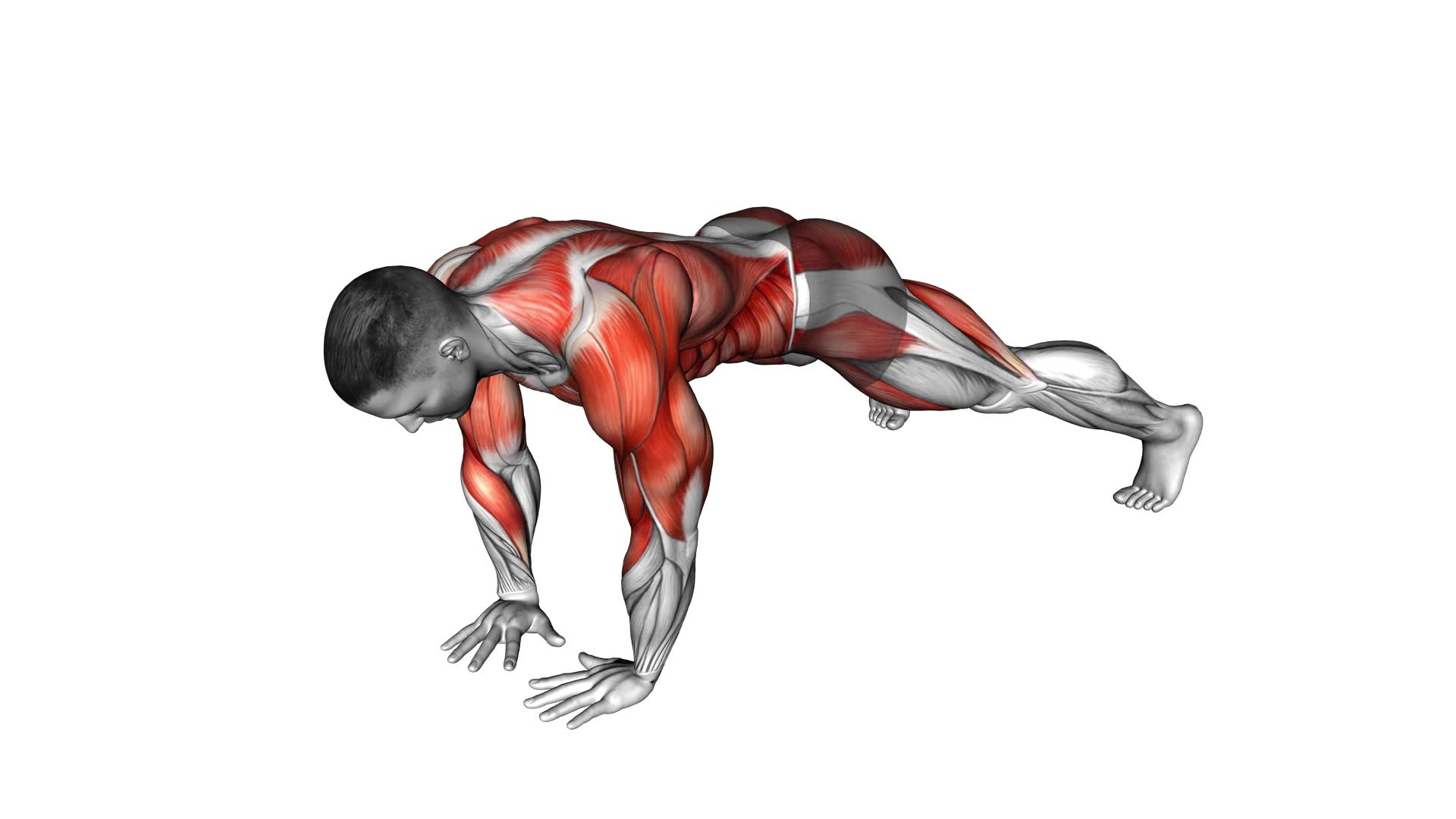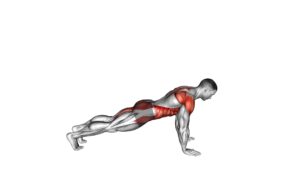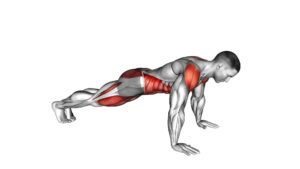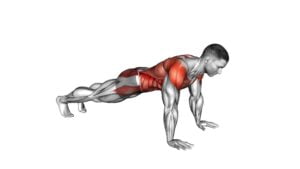Wide Plank Side Tap (male) – Video Exercise Guide & Tips

Are you looking for an effective exercise to strengthen your core and improve your stability? Look no further than the wide plank side tap!
Watch This Exercise Video
In this video exercise guide, we'll show you the proper form and technique to get the most out of this challenging move.
You'll also learn common mistakes to avoid and variations for progression.
Get ready to incorporate the wide plank side tap into your workout routine and take your fitness to the next level.
Let's get started!
Key Takeaways
- Improved core stability
- Strengthened core muscles, including abs and lower back
- Enhanced balance and body strength
- Reduced risk of injuries
Benefits of Wide Plank Side Tap
You will experience several benefits from incorporating wide plank side taps into your workout routine. One of the main benefits is improved core stability. As you perform the side taps, your core muscles, including your abs and lower back, work hard to maintain proper form and balance. This helps strengthen and stabilize your core, which is essential for overall body strength and injury prevention.
Additionally, wide plank side taps are great for increasing hip strength. The movement involves shifting your weight from side to side, engaging your hip muscles in the process. This can help to strengthen your hip abductors and adductors, which are responsible for moving your legs laterally.
By incorporating wide plank side taps into your routine, you can improve your hip strength, leading to better stability and performance in activities that require lateral movements. So, by adding wide plank side taps to your workout routine, you can enjoy the benefits of improved core stability and increased hip strength.
Now, let's move on to the next section and learn about proper form and technique.
Proper Form and Technique
To ensure proper execution of the wide plank side tap exercise, maintain a stable and aligned body position throughout the movement. Proper form and technique are essential to maximize the benefits of this exercise and avoid common errors.
First and foremost, it's important to start in a plank position with your hands directly under your shoulders and your body in a straight line. Engage your core to keep your hips level and prevent any sagging or arching of the back. This proper alignment will help you maintain stability and protect your lower back.
When performing the side tap, remember to keep your movements controlled and controlled. Avoid any jerking or bouncing motions, as this can put unnecessary strain on your joints and increase the risk of injury. Instead, focus on smoothly lifting one hand off the floor and tapping it to the opposite shoulder, while keeping your body stable and aligned.
Throughout the exercise, maintain a steady breathing pattern and avoid holding your breath. Breathing properly will help you maintain focus and stability, and also ensure that your muscles receive an adequate supply of oxygen.
Common Mistakes to Avoid
Avoiding common mistakes is crucial when performing the wide plank side tap exercise. To ensure that you're getting the most out of this exercise and preventing any potential injuries, it's important to maintain proper technique.
One common mistake to avoid is allowing your hips to sag or lift too high during the exercise. This can put excessive strain on your lower back and diminish the effectiveness of the exercise. Instead, focus on keeping your body in a straight line from your head to your heels, engaging your core muscles to maintain stability.
Another mistake to watch out for is rushing through the exercise and sacrificing proper form. It's important to perform each side tap with control and precision, ensuring that you're fully extending your leg to the side and tapping your foot lightly on the ground before returning to the starting position.
Variations for Progression
To progress the wide plank side tap exercise, try incorporating weighted ankle cuffs for added resistance. This advanced modification will challenge your core and lower body muscles even more.
Here are some alternative exercises you can try to further advance your plank workout:
- Elevated Side Plank: Elevate your feet on a bench or step to increase the difficulty of the exercise. This will engage your obliques and shoulders to a greater extent.
- Plank with Knee Taps: From a high plank position, alternate tapping your knees to the ground. This dynamic movement adds a cardiovascular component to the exercise and targets your abs and hip flexors.
- Plank Jacks: Start in a high plank position and jump your feet wide, then jump them back together. This plyometric exercise will challenge your core stability and increase your heart rate.
- Spiderman Plank: As you hold a plank position, bring your knee towards your elbow on the same side. This exercise targets your obliques, hip flexors, and shoulders.
- Plank with Shoulder Taps: From a high plank position, lift one hand and tap the opposite shoulder. Alternate sides. This exercise improves shoulder stability and core strength.
Incorporating these variations into your wide plank side tap routine will help you progress and continue challenging your muscles for optimal strength and stability.
Tips for Incorporating Wide Plank Side Tap Into Your Workout Routine
To incorporate wide plank side tap into your workout routine, follow these tips for maximum effectiveness.
First, consider incorporating cardio into your routine by performing the wide plank side tap in a circuit-style workout. This means alternating between the exercise and other cardio exercises such as jumping jacks or high knees. This will help elevate your heart rate and increase the calorie burn.
If you're a beginner, it's important to modify the wide plank side tap to suit your fitness level. You can start by performing the exercise on your knees instead of your toes. This will reduce the intensity and make it easier to maintain proper form. As you build strength and confidence, gradually progress to performing the exercise on your toes.
Another tip is to focus on maintaining proper form throughout the exercise. Keep your core engaged and your body in a straight line from head to toe. Avoid sagging or arching your back to ensure you're targeting the right muscles and minimizing the risk of injury.
Lastly, remember to listen to your body and take breaks as needed. Push yourself, but also know your limits. Incorporating the wide plank side tap into your workout routine can be a great way to challenge yourself and improve your overall fitness.
Frequently Asked Questions
How Many Calories Does the Wide Plank Side Tap Exercise Burn?
The wide plank side tap exercise is a great way to burn calories while improving your balance and stability. By engaging your core and working your muscles, this exercise can help you shed excess calories.
The exact number of calories burned will vary depending on factors such as your weight, intensity, and duration of the exercise. However, incorporating this exercise into your routine can contribute to your overall calorie burn and help you reach your fitness goals.
Can Wide Plank Side Tap Help With Improving Balance and Stability?
Improving balance and stability is a key benefit of the wide plank side tap exercise. By engaging your core muscles, this exercise helps to strengthen your balance and stability.
Additionally, there are variations of side plank exercises that can further enhance these aspects.
Adding wide plank side tap to your fitness routine is a great way to work on your core strength while improving your overall balance and stability.
Is It Safe to Perform Wide Plank Side Tap if You Have Lower Back Pain?
If you're dealing with lower back pain, it's important to approach wide plank side tap with caution. It may not be safe for you to perform this exercise as it puts strain on the lower back.
Instead, consider modifying the exercise by performing it on your knees or using an elevated surface for support. This can help reduce the pressure on your lower back while still allowing you to enjoy the benefits of wide plank side tap, such as improved core strength and stability.
How Often Should Wide Plank Side Tap Be Included in a Workout Routine?
To maximize the benefits of your workout routine, it's important to include the wide plank side tap exercise. This move targets your core, shoulders, and hips, improving stability and strength.
To perform it correctly, start in a plank position, then shift your weight to one hand and lift the opposite arm, tapping it to the side. Keep your core engaged and maintain a straight line from head to toe.
Incorporate this exercise regularly for a well-rounded workout.
Are There Any Modifications or Alternatives for Individuals With Wrist or Shoulder Issues?
If you're dealing with wrist or shoulder issues, there are modifications and alternatives available for the wide plank side tap exercise.
For wrist-friendly modifications, you can try performing the exercise on your forearms instead of your hands. This reduces the strain on your wrists.
As for shoulder-friendly alternatives, you can opt for exercises like lateral raises or standing side bends to target similar muscle groups without putting excessive pressure on your shoulders.
Remember to listen to your body and adjust accordingly.
Conclusion
Incorporating the wide plank side tap into your workout routine offers numerous benefits. It targets your core, arms, and legs while improving balance and stability.
To maximize the exercise's effectiveness, maintain proper form and technique, avoiding common mistakes like sagging hips or collapsing shoulders.
As you progress, try variations such as adding a knee tuck or performing the side tap on an unstable surface.
Remember to consult a fitness professional for guidance and make sure to challenge yourself while staying safe.

Author
Years ago, the spark of my life’s passion ignited in my mind the moment I stepped into the local gym for the first time. The inaugural bead of perspiration, the initial endeavor, the very first surge of endorphins, and a sense of pride that washed over me post-workout marked the beginning of my deep-seated interest in strength sports, fitness, and sports nutrition. This very curiosity blossomed rapidly into a profound fascination, propelling me to earn a Master’s degree in Physical Education from the Academy of Physical Education in Krakow, followed by a Sports Manager diploma from the Jagiellonian University. My journey of growth led me to gain more specialized qualifications, such as being a certified personal trainer with a focus on sports dietetics, a lifeguard, and an instructor for wellness and corrective gymnastics. Theoretical knowledge paired seamlessly with practical experience, reinforcing my belief that the transformation of individuals under my guidance was also a reflection of my personal growth. This belief holds true even today. Each day, I strive to push the boundaries and explore new realms. These realms gently elevate me to greater heights. The unique combination of passion for my field and the continuous quest for growth fuels my drive to break new ground.







